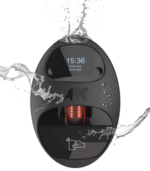
Safe Spaces, Happy Faces: How Employers Benefit When They Prioritise Workplace Security
As we approach 2025, the landscape of access control solutions in the UK is undergoing significant transformation. Advancements in technology, evolving security requirements, and a heightened focus on user convenience are driving this evolution. To maintain a competitive edge, businesses must stay informed about these emerging trends and understand their implications.
 Biometric authentication methods, such as facial recognition and fingerprint scanning, are becoming increasingly prevalent in the UK. These technologies offer enhanced security by ensuring that access is granted solely to authorised individuals, thereby reducing the risks associated with lost or stolen access cards.
Biometric authentication methods, such as facial recognition and fingerprint scanning, are becoming increasingly prevalent in the UK. These technologies offer enhanced security by ensuring that access is granted solely to authorised individuals, thereby reducing the risks associated with lost or stolen access cards.
The UK’s biometric technology market is projected to reach approximately £6.5 billion by 2030, with a compound annual growth rate (CAGR) of 19.6% from 2024 to 2030. Source: Grand View Research
In the retail sector, facial recognition is utilised to personalise customer experiences and deter shoplifting. Healthcare facilities employ biometric systems to secure patient data and control access to sensitive areas.
 The shift towards cloud-based access control systems is accelerating, driven by the need for scalability, flexibility, and remote management capabilities. These systems enable businesses to monitor and control access points from any location, facilitating seamless integration with other security solutions.
The shift towards cloud-based access control systems is accelerating, driven by the need for scalability, flexibility, and remote management capabilities. These systems enable businesses to monitor and control access points from any location, facilitating seamless integration with other security solutions.
The UK’s cloud-based Electronic Access Control Systems (EACS) market is expected to grow by 20% annually, with 70% of organisations planning to adopt these systems by 2025. Source: Credence Research
Artificial Intelligence (AI) is playing a pivotal role in enhancing access control systems. AI algorithms can analyse patterns to detect anomalies, predict potential security threats, and automate responses, thereby bolstering overall security postures.
Financial institutions are leveraging AI-driven access control to monitor and analyse access patterns, enabling rapid identification of suspicious activities and prompt action.
With the increasing convergence of physical security systems and IT networks, safeguarding access control solutions against cyber threats is paramount. Implementing robust encryption protocols and regular security updates is essential to protect sensitive data.
The global biometrics market is expected to grow from £39.12 billion in 2023 to £45.89 billion in 2024, highlighting the rapid adoption of biometric systems. Source: Research and Markets
The utilisation of smartphones as access credentials is gaining momentum. Mobile access solutions offer convenience and reduce the need for physical cards, aligning with the growing demand for touchless technologies.
The UK’s contactless biometrics technology market is expected to reach approximately £2.2 billion by 2030, growing at a CAGR of 20.1% from 2024 to 2030. Source: Grand View Research
Adherence to data protection regulations, such as the UK’s Data Protection Act 2018, is critical. Access control systems must be designed to ensure user privacy and comply with legal requirements, necessitating transparent data handling practices.
Educational institutions are implementing access control systems that comply with privacy laws, ensuring that student data is protected while maintaining secure campus environments.
The commercial landscape is in a state of constant flux, and so are the security challenges that come with it. There’s no time like the present to reassess and fortify your access control system.
Here are three reasons why you should reach out to us now.
1. Stay Ahead with Innovative Solutions: In a world where threats are becoming increasingly sophisticated, settling for outdated security systems is not an option. Our cutting-edge biometric and CCTV solutions ensure that you’re not just keeping up but staying ahead.
2. Tailored for You: Generic solutions often lead to vulnerabilities. We offer a bespoke approach to security, designed to meet the unique needs and challenges of your commercial business.
3. 24/7 Exceptional Customer Service: Security is a round-the-clock concern, and so is our customer service. From installation to regular maintenance checks, our support teams are always at your disposal to ensure seamless operation. Our installation and feedback scores from our customers in the last year consistently score over 4.5 out of 5.
Call us today on 0333 567 6677 (UK) or 01 68 333 68 (IRE) to book a free site visit with one of our friendly security consultants and start future proofing your access control, today.
